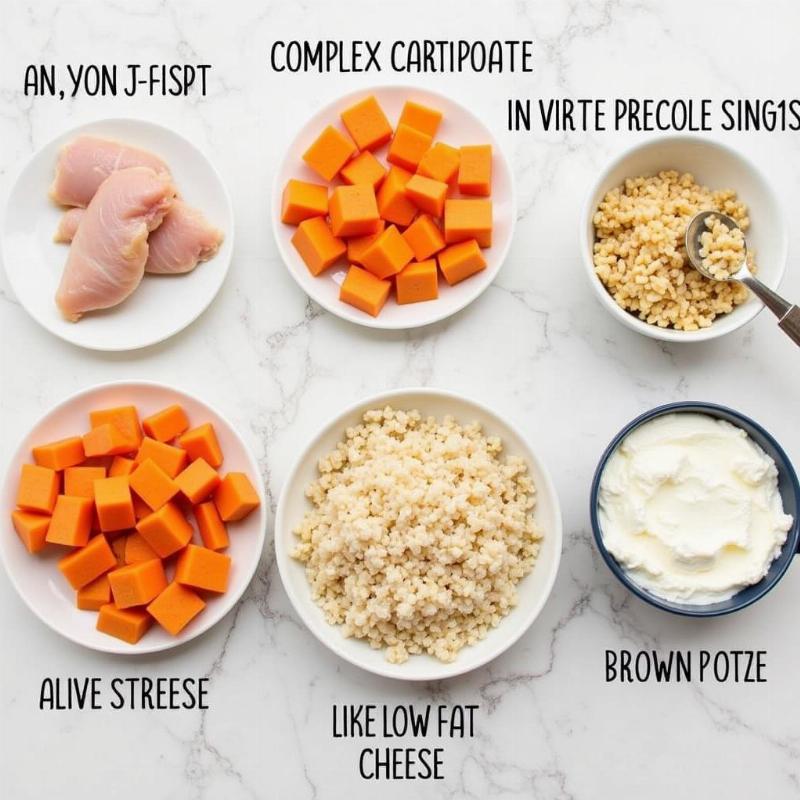A low-fat diet for dogs is often necessary for managing certain health conditions like pancreatitis, inflammatory bowel disease, or simply for weight control. Creating a homemade low-fat diet allows you to control the ingredients and ensure your dog is receiving optimal nutrition while addressing their specific dietary needs. This comprehensive guide will walk you through the process of preparing a healthy, low-fat diet for your furry friend, right in your own kitchen.
Understanding the Need for a Low-Fat Diet
Several health issues in dogs necessitate a low-fat diet. Pancreatitis, a painful inflammation of the pancreas, often requires a drastic reduction in dietary fat to allow the organ to heal. Inflammatory bowel disease (IBD) can also benefit from low-fat meals, easing digestion and reducing inflammation. Even for dogs without specific health concerns, a low-fat diet can be beneficial for weight management and overall health.
Key Ingredients for a Homemade Low-Fat Dog Diet
Choosing the right ingredients is crucial for a successful low-fat dog diet. Lean protein sources are essential. Skinless chicken breast, turkey breast, and white fish are excellent options. Low-fat dairy products like cottage cheese (in moderation) can also contribute protein and calcium. Complex carbohydrates like brown rice, sweet potatoes, and oatmeal provide energy and fiber.
 Homemade Low-Fat Dog Food Diet
Homemade Low-Fat Dog Food Diet
Creating a Balanced Low-Fat Meal Plan
A balanced low-fat meal plan should consist of roughly 50% lean protein, 25% complex carbohydrates, and 25% fruits and vegetables. Fruits and vegetables like green beans, carrots, and apples provide essential vitamins and minerals. Remember to avoid high-fat fruits like avocados. Consult with your veterinarian for a personalized meal plan based on your dog’s specific needs, breed, and activity level. They can help you calculate the correct calorie intake and ensure the diet meets all your dog’s nutritional requirements.
Sample Low-Fat Dog Food Recipes
Here are a few simple and delicious low-fat dog food recipes to get you started:
- Chicken and Rice: Combine cooked, shredded chicken breast with cooked brown rice and steamed green beans.
- Turkey and Sweet Potato: Mix cooked ground turkey with cooked, mashed sweet potato and chopped carrots.
- Fish and Oatmeal: Flake cooked white fish and mix it with cooked oatmeal and steamed broccoli.
Tips for Transitioning to a Low-Fat Diet
Transitioning your dog to a low-fat diet should be gradual to avoid digestive upset. Start by mixing a small amount of the new food with their current food, gradually increasing the proportion of the low-fat food over several days. Monitor your dog’s stool for any signs of diarrhea or constipation and adjust the transition speed accordingly.
Monitoring Your Dog’s Progress
Once your dog is fully transitioned to the low-fat diet, it’s essential to monitor their progress. Regular weigh-ins and veterinary checkups are crucial, especially for dogs with health conditions. Your veterinarian can assess the effectiveness of the diet and make adjustments as needed.
Is a Low-Fat Diet Right for All Dogs?
A low-fat diet is not suitable for all dogs, especially puppies and pregnant or lactating females. These dogs require higher levels of fat for growth and development. Always consult with your veterinarian before making any significant changes to your dog’s diet.
Conclusion
A homemade low-fat diet for dogs can be a highly effective way to manage various health issues and promote overall well-being. By carefully selecting ingredients and following a balanced meal plan, you can provide your dog with a nutritious and delicious diet that supports their specific needs. Remember to consult your veterinarian for personalized guidance and monitor your dog’s progress regularly.
FAQ
- How do I know if my dog needs a low-fat diet? Consult your veterinarian. They can diagnose any underlying health conditions that may require a low-fat diet.
- What are some signs my dog isn’t tolerating a low-fat diet? Watch for vomiting, diarrhea, or changes in appetite.
- Can I give my dog low-fat treats? Yes, but choose treats specifically formulated for low-fat diets. Check with your vet for recommendations.
- What are some good sources of fiber for a low-fat diet? Pumpkin, sweet potatoes, and brown rice are excellent sources of fiber.
- How often should I feed my dog a low-fat diet? Most adult dogs do well with two meals a day. Your vet can recommend the best feeding schedule for your dog.
- Can I add supplements to my dog’s low-fat diet? Consult your veterinarian before adding any supplements, as some can interact with medications or exacerbate existing health conditions.
- Is it more expensive to make homemade low-fat dog food? It can be, depending on the ingredients you choose. However, many owners find the peace of mind and control over ingredients worth the cost.
Beautdogs.us is your premier resource for all things dog-related in the US. We offer expert advice on dog breeds, care, and products, empowering both novice and experienced dog owners. Discover a wealth of information on our website, from breed-specific guides to nutritional advice. Beautdogs.us is your trusted partner in providing the best care for your beloved canine companion. Contact us for personalized guidance: Email: [email protected], Phone: +1 501-555-7529. Visit Beautdogs.us today!